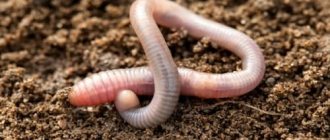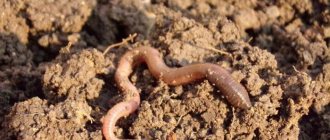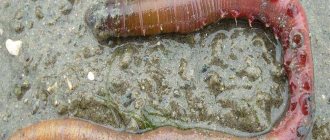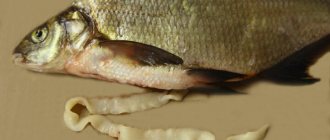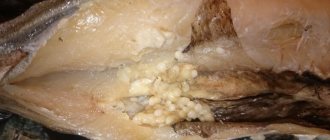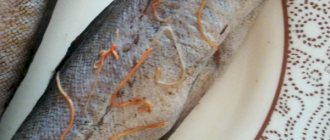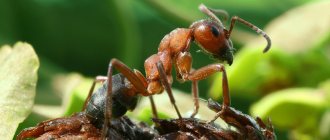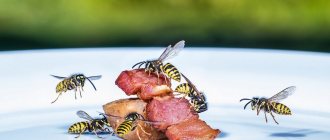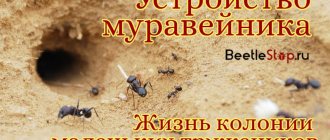Earthworms or earthworms are widespread in nature and live on all continents. Anyone who believes that they are needed only as hook bait used by fishermen is wrong. The benefits of these invertebrates are enormous. They mix the soil by eating waste from other animals. Flavor it with useful substances. We see them because they come to the surface when it rains. Water entering their homes makes breathing difficult, threatening their lives.
Lifestyle and habitat
According to their lifestyle, they are divided into those who live on the surface, hiding in a layer of last year’s foliage, never climbing more than 15 cm underground. Burrowers can burrow into the ground to a depth of more than a meter. At the same time, their holes in the ground help to mix and loosen its fertile layer. The main activity of these invertebrates occurs at night, when they feed intensively.
Moving underground, they constantly loosen the soil, helping the penetration of oxygen and moisture to the roots. Plants in such soil feel much better and develop well. The movement of soil as a result of their vital activity has a positive effect on its quality. They enrich the soil with humus; their presence in it can serve as a good way to determine fertility.
Nursery filling technology
When growing worms, the nursery container is filled 50% with humus. To increase the softness of the soil, it is recommended to mix soil and newspaper or cardboard.
The earth is moistened as much as possible, however, if you squeeze a handful of the mixture in your hand, then water should not flow from it.
The first few days the compost releases ammonia, so putting worms in it is unacceptable.
For 1 m2 of compost mixture you will need about a kilogram of worms. Based on this calculation, worms settle into prepared grooves in the ground. In this case, it is necessary to leave part of the soil in which the worms lived. The place where the worms are transplanted is moistened and covered with a piece of cardboard.
During the first 3-4 days, the worms will adapt to the new habitat, so any interference in this process is prohibited.
If, after the adaptation period, the worms independently distributed themselves throughout the nursery, then acclimatization was completed successfully. All that remains is to add food.
You also need to remember that the mixture where the worms live should under no circumstances be allowed to dry out. The soil should be slightly moist.
Excessive watering is also harmful to the life of the worms, since they breathe through the skin (this explains the fact that when it rains, the worms crawl out from their shelters).
The place where you plan to breed worms should be calm and quiet. It is necessary to exclude the occurrence of strong vibration and other noise.
Structure
Worms differ from each other in size - their body length can vary from 2 cm to several meters. Such giants live in Australia. The body is divided into segments (rings), on which there are small bristles that help them move. This structure allows you to greatly change its length, increasing the body several times.
With its bristles it holds onto the ground so firmly that it is simply impossible to pull it out of the hole. The worm will either run away or break: each of us was probably convinced of this in childhood. The body consists of two types of muscles - longitudinal and transverse; by contracting them, the animal moves.
The body is covered with mucus, which is a very good antiseptic; this property was noticed back in the Middle Ages. There is no vision, but they have the unique ability to restore a lost area of the body.
Economic efficiency
In one year of work on breeding worms with minimal costs for creating a nursery of 2 m2, you can get about 15 thousand worms and about one ton of humus. If on average 1 worm costs 1.5 rubles on the market, then the total profit from the sale of worms per year will be 22.5 thousand rubles. In addition, the cost of selling a ton of humus and worm tea can be added to the calculation. As you can see, with minimal costs you can get a good profit.
The reasons for the popularity of worm farming are:
- waste-free technology;
- minimal costs for food and care of worms;
- speed of breeding;
- availability of demand and wide sales opportunities;
- minimum number of workers to service the vermifarm;
- simplicity of equipment.
Worm farming is definitely a lucrative business. The profitability of the vermifarm is at the level of 130-145%. Some worm breeding business owners manage to raise their profitability levels even higher.
All housewives are now talking about healthy food and many are trying to look for natural and healthy products, including meat. Quail breeding as a business is a fairly open niche and you can establish a sales market even if you have a small farm. Read about how much it costs to open such a business and whether it is profitable on our website.
Read about growing champignons for sale at home in this topic. Details about the process technology.
Nutrition
The answer to the question of what earthworms can eat is very simple - everything. Their eating process is very interesting: they swallow a certain amount of soil and select all the organic substances from it. They eat the food they find underground in small pieces, suck on it, and drag it into holes. They can stock up on food for a “rainy day” in special burrows, which are sealed for safekeeping. After assimilation of food, they come to the surface, where they excrete the remains of vital activity, doing this in strictly defined places.
Reproduction and lifespan
The ability to produce offspring appears when the individual reaches six months of age. The incubation period depends on weather conditions and lasts 1-5 months. They are not divided by sex - they are asexual hermaphrodites and reproduce by cross-fertilization. They find each other by smell on warm, humid evenings.
The reproductive organ is the widest belt on the body, several times larger than the rest. In it, the eggs are fertilized and develop. They lay eggs in the ground in cocoons containing about twenty future worms each. In three to four months, the worms grow from larvae to the size of an adult.
Possible implementation options
Sorting of worms in the nursery occurs every 3-4 months. For this purpose, the top layer of soil is removed, then the worm habitat layer and the humus layer are removed.
Next, the worms themselves are sorted - the adult ones go for sale, and the crayons are returned back. The growing process is completely resumed after sorting.
Beginning businessmen often ask the question: where to sell worms?
First of all, fishermen need worms as bait. Therefore, you can safely go to the market and sell pre-prepared packages of worms. The price of one package of 30 worms is 40-50 rubles.
Worms are very well bought by pet store managers and fish farms.
You can also set up the production of humus for indoor plants. Humus is an indispensable fertilizer for summer residents and gardeners. Another option for making a profit is selling “worm tea”. To collect such a product, a small hole is made in the bottom of the container where the worms are kept.
Benefit
Charles Darwin was the first to speak about the benefits of earthworms. He even suggested that they have intelligence, noting that pulling a piece of leaf into a hole occurs from the narrow end, and a bunch of pine needles pulls at the base to make it easier to get into. He observed them almost all his life and wrote the scientific work “The Formation of the Vegetative Layer of the Earth by the Activity of Earthworms and Observations on Their Lifestyle” (1881).
Vermicompost production
The first enthusiasts to pay attention to the possibility of using earthworms to process organic matter and produce vermicompost were American farmers. The fertility of earthworms is used to obtain biomass, which expands the food rations of domestic animals and poultry. Vermicompost reduces the number of garden pests on the site. Binds the remains of heavy metals and removes residual radiation, purifying the soil, and helps to obtain a good harvest without the use of chemical fertilizers.
What are they useful for in the garden?
They are capable of restoring in a short period of time the fertile layer of soil lost as a result of the unreasonable use of chemical fertilizers, fires or other negative impacts. The product of their vital activity - vermicompost - restores and improves its fertile properties. Due to its natural origin, humus is not capable of burning the soil or harming it in any other way.
Worms are very useful in the garden; breeding them on the plot is not difficult. It is enough to arrange a compost pit where you can put weeds, carrion and any organic waste. Soon these useful creatures will appear on your site. There is no desire to wait - you can buy them; worms are offered for fishing everywhere.
Choosing food
You can feed your new pets grass, leaves, peelings of fruits and vegetables, except onions, garlic and citrus fruits, flour products, egg shells, coffee grounds and tea leaves. They are very fond of worms and humus from horse, goat or cow manure. The main thing is not to give manure fresh. Due to the high concentration of ammonia, it can become a real poison for them.
You can feed meat, fish and dairy waste, but only in small quantities. Pickled foods should not be given.
By April you will receive large and healthy worms that are ready to make any garden bed fertile and significantly increase your yields.
Backyard breeding
The breeding process is vermiculture, which allows you to process a large volume of organic waste. Well suited for processing waste products of cattle and poultry kept on a private farm into high-quality environmentally friendly fertilizer - vermicompost. Vermiculture is a promising area that can help reduce the amount of chemical fertilizers used in agriculture.
How to make and prepare a worm trap
An easy way is to use an old wooden box larger in size or make a new one with dimensions one meter by one meter. To remove excess moisture, drill a series of holes at the bottom. Place a layer of compost with household organic waste there. Level it, moisten it well, and cover it with dry leaves, straw or burlap.
Settlement of the worm's nest
Worms can be bought or found in the forest, usually hiding in shaded, damp places. Place them in a container along with the soil and place them in the prepared box. To get a good result, it is best to plant it in compost, which you can prepare yourself on the site. Collect weeds and organic waste in an iron barrel.
When the compost is ripe, it can be populated. It is advisable to keep an eye on your pets for some time: if they are active and try to hide from daylight, then everything is going well. It is important to remember: for good adaptation of invertebrates in a new place, feeding should begin no earlier than 2-3 weeks; until this point, periodic moistening of the soil is sufficient.
It is not advisable to overfeed; large amounts of organic matter also have a bad effect on them. It can ferment, releasing acid into the soil. Neutral or slightly alkaline soil is considered favorable. The food should be chopped, throwing it into a worm bin, for example, a whole apple, is not advisable, they do not have teeth. The first harvest can be harvested from your specific garden bed in a couple of months. The optimal quantity is considered to be: a thousand individuals per 1 sq.m. surfaces.
How to care
Caring for worms is easy. If you are breeding on a commercial scale, they need to be fed with compost and any waste containing organic matter. Heaps or containers with crops are fed and watered once a day; per day they process an amount of feed equal to their own weight. Taking advantage of the fact that worms “go to the toilet” in a certain place, the worm chamber is divided into three parts.
- “Dining room” - you put food in this part;
- the residential area where invertebrates live and reproduce;
- in the third part they will store human waste.
Every day you can get from the heap the most valuable fertilizer - vermicompost, its volume is comparable to the amount of compost added as feed. Before adding the next portion of feed, make sure that the previous one is processed.
Selecting a room
Those who are planning to breed worms should take care to increase the area of the worm farm, since worms reproduce very quickly. Absolutely any room can be used as a room. The main condition is heating. It is also necessary to take care of air humidity.
Room for a vermifarm
Basically, a garage, basement, attic or other outbuilding is used as a room for breeding worms. It is important to remember that the minimum daily temperature when growing worms should not fall below 4°C, otherwise the worms will hibernate. At temperatures above 36°C, the worms die.
Role in nature
It is difficult to overestimate the role of worms in soil formation. In the fall, after the leaves fall, bacteria take over their disposal, turning the leaves into compost. Then the worms, feeding, will turn it into vermicompost and at the same time mix it with the soil, saturating it with the substances necessary for plant nutrition. The waste product of invertebrates is rich in mineral fertilizers. A large number of them in the soil guarantees its productivity.
Now you know what benefits earthworms bring. Having noticed them in your summer cottage, you will not ask: are they harmful? You can be sure: with such helpers, your hopes for a good, environmentally friendly harvest will at least double.
Vermiculture
Currently, due to the frequent use of mineral fertilizers, pesticides, and herbicides, the population of earthworms has decreased significantly.
Some people are specifically engaged in vermicultivation, that is, the artificial propagation of earthworms. Vermiculture is a business that does not require large start-up capital. The demand for both earthworms themselves and the organic fertilizer they produce has been increasing recently.
You can breed worms yourself. Liming the soil will help increase the number of earthworms. Or they are bred in the following way. Place leaves, food waste, humus, manure in a dug hole and throw in worms. After a while, you will notice that there are much more worms in the soil. For faster reproduction, worms are fed with a three-day tincture of cut grass, nettles, dandelions, and food waste.
Summarizing what has been said, I want to say that, after all, the benefits for people from earthworms are much greater than the harm.
To prove it, watch this video “The Amazing Inhabitants of the Garden.” I wish you good harvests!

